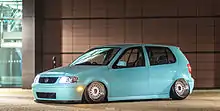Stance (vehicle)
The stance of a vehicle is determined by its suspension height and the fitment of the wheels in the fender arches. It may refer to any vehicle, including sports cars, pickup trucks and off-road vehicles, however it is mostly associated with lowered sports cars, sedans, hatchbacks, vans and other body styles of passenger cars. The main parameters of the vehicle's stance are suspension height and position of the wheels. Suspension height usually depends on the suspension components including springs, coilover, air bags and camber plates. Wheel position usually depends on the rim size, off-set or wheel spacers. Tire fitment also plays a big role from both visual and functional perspective. [1]

Customization Style

The term "Stance" or "Stanced" is often used to describe a car customization style. It can be used in conjunction with "slammed" or "lowered" (not to be confused with a lowrider). Key elements of the stance style are: lowered suspension (lowering springs, coilovers or air suspension), large wheels, stretched tires and negative camber. Any make and model of a car produced between circa 1970s and today can fit in this category. The main purpose of a stanced car project is often an improved visual appeal rather than performance characteristics or handling, however some cars combine both. Stance is related to other modification styles such as JDM (Japanese Domestic Market), Euro style and VIP style.
Negative Camber
Camber is a measurement from the centerline of the wheel/tire relative to the road's surface. Negative camber is when the top of the wheel/tire angles inward toward the center of the vehicle. When done sparingly, negative camber greatly improves the handling characteristics of a vehicle. It does this by keeping the center of the tire perpendicular to the road when the car is turning. Therefore, allowing the optimum amount of tire tread to contact the road. [2]
Adversely, negative camber will decrease tire grip in straight line acceleration and braking. This is due to the same reasoning, when the vehicle is not turning less tread will be in contact with the road or track. Resulting in less grip and lost performance. Many drift cars, however, use negative camber on their front wheels for better handling characteristics as the negative camber keeps the contact patch of the tire perpendicular to the road when going through turns with much steering angle.
Stanced vehicles employ all ranges of negative camber. There is no set standard on what degree of camber should be used. However, most normal vehicles maintain about 0.5° - 1° of camber. In the stance community, some owners run up to 45° of negative camber to achieve the stance they are looking for. [3]
Origin
Stance is a style of car customization derived from auto sports such as Formula 1 and Drifting. Typically high power output cars designed for the race tracks feature extremely low and stiff suspension along with light and wide sport wheels for better handling and cornering on the race tracks. Enthusiasts began looking to replicate this style and make their cars look and perform similarly to the cars used in auto sport.[4] If the original approach was based on the functional standpoint, modern modification style is often based on the visual standpoint. Extremely lowered cars tend to be show cars. They typically do not play the role of daily driver or race car. Extreme body work, suspension and wheel setups often make them less comfortable to drive on public roads and sometimes unsafe.
.jpg.webp)
Culture and Events
.jpg.webp)
Stance culture heavily revolves around making a vehicle unique from all others. Apart from the basics like lowering the car excessively, big wheels, and body kits - everything else is done to set the car apart. Stance enthusiasts often regard form as greater than function. Modification is not done for approval, but in order to challenge the norm.[5]
_-_euromagic_voomeran_GOLF5_R32.jpg.webp)
The "stance" style originated in Japan but has spread all to many other countries, with stance centric car shows hosted around the world on most continents.[6] Events happen every year that host many stanced cars, such as Stancenation, Wörthersee Treffen, FittedUK, Wekfest, Raceism and H2Oi. There is also a significant stanced car presence at larger events such as SEMA, Tokyo Auto Salon and Osaka Auto Messe.[7]
References
- "The Secrets Of Stance! - Popular Hot Rodding Magazine".
- "Learn Camber, Caster, and Toe". Come and Drive It. Retrieved 25 November 2018.
- "Why do some tuned cars have very inclined tires?". Stack Exchange. Stack Exchange Inc. Retrieved 25 November 2018.
- "Everybody Stance Now - Tech - Super Street Magazine".
- Hernandez, Freddy. "Why We All Owe Stance Culture A Huge Apology". Jalopnik. Retrieved 25 November 2018.
- McDonnell, Grant. "How to Slam Your Car". RedBull. Retrieved 25 November 2018.
- "West-Side Style: Osaka Auto Messe". Speedhunters. 2014-02-18. Retrieved 2019-09-01.
| Wikimedia Commons has media related to Stanced cars. |